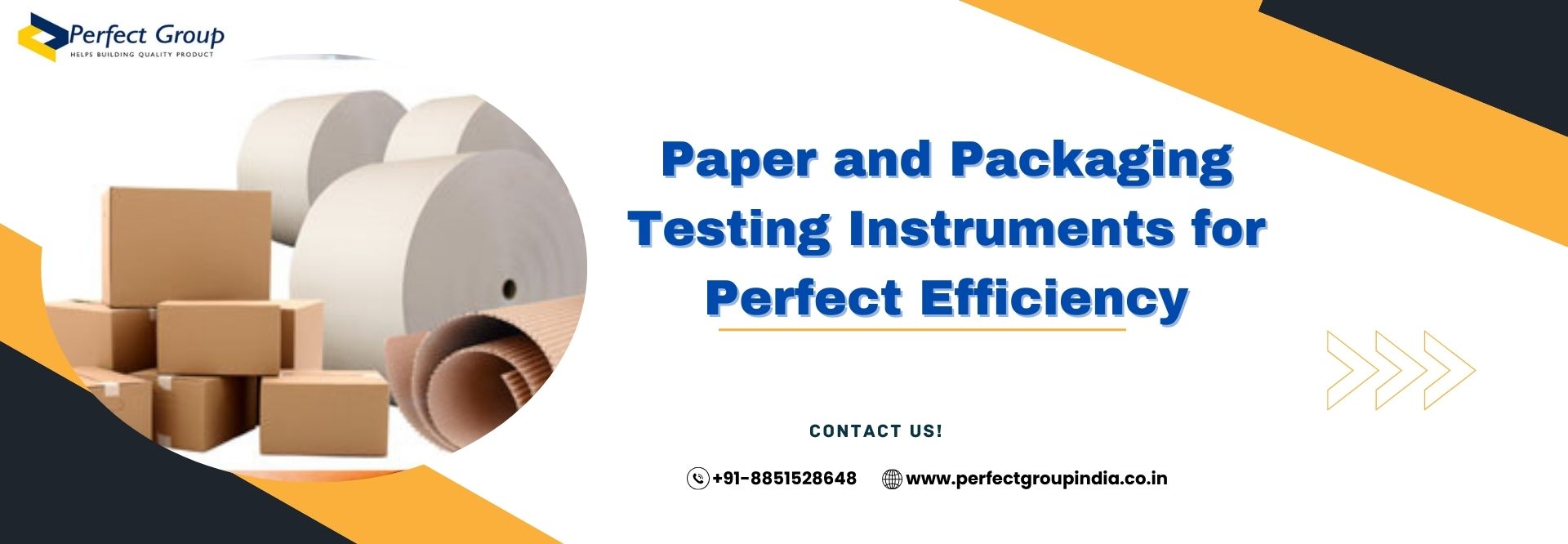Paper and Packaging Testing Instruments for Perfect Efficiency
In the realm of paper and packaging testing instruments industries, ensuring the quality, durability, and safety of products is paramount. From corrugated boxes to paperboard packaging, manufacturers rely on robust testing instruments to assess various properties and characteristics. In this comprehensive guide, we delve into the world of paper and packaging testing instruments, exploring their significance, types, applications, and benefits in achieving perfect efficiency and product excellence.
Tensile Testers: Measure the tensile strength and elongation properties of paper and packaging materials, helping determine their durability and resistance to tearing or stretching.
Burst Testers: Determine the burst strength of materials by subjecting them to hydraulic pressure, simulating real-world conditions and assessing their ability to contain contents without rupturing.
Edge Crush Testers: Evaluate the strength of corrugated board edges, providing insights into their structural integrity and suitability for packaging applications.
Moisture Meters: Quantify the moisture content of paper and packaging testing instruments, crucial for maintaining product stability, preventing mold growth, and ensuring packaging integrity.
Thickness Gauges: Measure the thickness of paper and packaging testing instruments with precision, allowing manufacturers to monitor consistency and compliance with specifications.
Friction Testers: Assess the coefficient of friction between packaging surfaces, aiding in the selection of materials and optimizing packaging designs for smooth handling and transportation.
Impact Testers: Simulate impact forces experienced during handling and shipping, evaluating the resilience and protective capabilities of packaging materials against damage.
Seal Strength Testers: Determine the integrity of seals and closures in flexible packaging, ensuring product freshness, containment, and tamper resistance.
Creep Testers: Assess the long-term deformation properties of materials under sustained load, providing insights into their performance over time and under stress.
Food and Beverage: Ensuring packaging integrity, barrier properties, and shelf-life extension.
Pharmaceuticals: Verifying the integrity of blister packs, pouches, and medication packaging.
Consumer Goods: Assessing packaging durability, aesthetics, and brand presentation.
E-commerce and Logistics: Optimizing packaging designs for efficient shipping and minimizing product damage.
Sustainable Packaging: Evaluating the eco-friendliness and recyclability of materials to meet sustainability goals.
Cost Reduction: Identify potential packaging flaws early in the design phase, minimizing waste, rework, and product recalls.
Customer Satisfaction: Deliver reliable and durable packaging solutions that protect products and enhance consumer experiences.
Regulatory Compliance: Ensure adherence to industry standards, regulations, and certifications, mitigating legal risks and liabilities.
Innovation Catalyst: Drive innovation and product development by understanding material properties and performance limitations.
Introduction
Paper and packaging testing instruments play crucial roles in countless industries, ranging from food and beverage to pharmaceuticals and logistics. The quality and reliability of these materials directly impact product protection, branding, and consumer satisfaction. To meet stringent quality standards and regulatory requirements, manufacturers employ advanced testing instruments designed specifically for paper and packaging testing instruments materials.Significance of Testing Instruments
Paper and packaging testing instruments serve multiple purposes, including quality control, performance evaluation, and compliance assurance. By subjecting materials to various tests, manufacturers can identify potential weaknesses, optimize designs, and ensure products meet or exceed industry standards. Moreover, testing instruments enable continuous improvement by providing valuable insights into material behavior and performance under different conditions.Types of Testing Instruments
Compression Testers: Assess the compressive strength of packaging materials, such as corrugated boxes, to evaluate their ability to withstand stacking and transportation pressures.Tensile Testers: Measure the tensile strength and elongation properties of paper and packaging materials, helping determine their durability and resistance to tearing or stretching.
Burst Testers: Determine the burst strength of materials by subjecting them to hydraulic pressure, simulating real-world conditions and assessing their ability to contain contents without rupturing.
Edge Crush Testers: Evaluate the strength of corrugated board edges, providing insights into their structural integrity and suitability for packaging applications.
Moisture Meters: Quantify the moisture content of paper and packaging testing instruments, crucial for maintaining product stability, preventing mold growth, and ensuring packaging integrity.
Thickness Gauges: Measure the thickness of paper and packaging testing instruments with precision, allowing manufacturers to monitor consistency and compliance with specifications.
Friction Testers: Assess the coefficient of friction between packaging surfaces, aiding in the selection of materials and optimizing packaging designs for smooth handling and transportation.
Impact Testers: Simulate impact forces experienced during handling and shipping, evaluating the resilience and protective capabilities of packaging materials against damage.
Seal Strength Testers: Determine the integrity of seals and closures in flexible packaging, ensuring product freshness, containment, and tamper resistance.
Creep Testers: Assess the long-term deformation properties of materials under sustained load, providing insights into their performance over time and under stress.
Applications of Testing Instruments
Paper and packaging testing instruments find applications across diverse industries and product categories:Food and Beverage: Ensuring packaging integrity, barrier properties, and shelf-life extension.
Pharmaceuticals: Verifying the integrity of blister packs, pouches, and medication packaging.
Consumer Goods: Assessing packaging durability, aesthetics, and brand presentation.
E-commerce and Logistics: Optimizing packaging designs for efficient shipping and minimizing product damage.
Sustainable Packaging: Evaluating the eco-friendliness and recyclability of materials to meet sustainability goals.
Benefits of Testing Instruments
Quality Assurance: Guarantee product quality and consistency through rigorous testing and compliance verification.Cost Reduction: Identify potential packaging flaws early in the design phase, minimizing waste, rework, and product recalls.
Customer Satisfaction: Deliver reliable and durable packaging solutions that protect products and enhance consumer experiences.
Regulatory Compliance: Ensure adherence to industry standards, regulations, and certifications, mitigating legal risks and liabilities.
Innovation Catalyst: Drive innovation and product development by understanding material properties and performance limitations.
